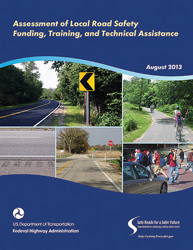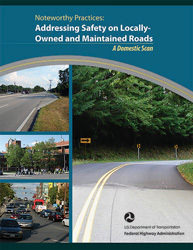U.S. Department of Transportation
Federal Highway Administration
1200 New Jersey Avenue, SE
Washington, DC 20590
202-366-4000
| < Previous | Table of Contents | Next > |
Obtaining the necessary human and financial resources is a major consideration in implementing any safety project or program. Harnessing local funding sources and staff resources is often the quickest way to implement projects. For example, maintenance or public works staff can implement low-cost projects such as maintenance or replacement of signs, maintenance of striping, and/or vegetation control as part of their regular duties.
Some safety project can be 100 percent Federally funded while others may be eligible for an increased Federal share. Agencies also can use locally generated funds as a match to leverage State or Federal dollars. The FHWA, Bureau of Indian Affairs (BIA), National Highway Traffic Safety Administration (NHTSA), and other Federal agencies distribute Federal transportation funding to states and other jurisdictions. State DOTs, state police agencies, and various other state institutions typically administer the disbursement of Federal transportation funding to smaller jurisdictions.
Procedures and requirements governing grant application processes vary by state. For instance, some states dedicate funds for local safety projects while others emphasize local roadway projects. Also, some state departments of transportation (DOT) use a centralized office or department to prioritize and program funds for local safety (or local roadway) projects, others allocate these responsibilities to the various DOT regions or districts, yet other States use a hybrid approach combining elements from each of these approaches. The FHWA “Assessment of Local Road Safety” Report provides additional information and insight on this topic (see the Resources section at the end of this chapter).
The Local Technical Assistance Program (LTAP) web site describes the various types of local agency support provided by state DOTs – a useful first stop for identifying the resources available by state.
Agencies should look beyond safety focused funding programs for access to a broader set of funding pools. By incorporating safety treatments into maintenance or capital improvement projects, agencies may be able to secure more funding than they would if they limited their applications strictly to safety programs. The evidence that safety improvements will occur if the “non-safety focused” project is implemented (because of the inclusion of safety treatments) could give the project a higher score, thereby improving its chances of being funded. This is because many state and Federal programs include application scoring criteria that give projects with a safety benefit higher scores. Likewise, safety is often a component of scoring systems some regional and metropolitan planning agencies use to select projects for inclusion in the Transportation Improvement Program (TIP). The FHWA publication Good Practices: Incorporating Safety into Resurfacing and Restoration Projects provides helpful guidance on incorporating safety features into non-safety focused projects. Please see the Resources section for more information. Finally, in some cases safety improvements can be included as part of the conditions of approval for a private development if there sufficient evidence connecting the proposed land use to the safety issue.
Major Safety Funding Programs of MAP-21. The current transportation bill, MAP-21, outlines Federal priorities for the transportation system. It includes several provisions which allocate funds to states for safety improvements. The Highway Safety Improvement Program (HSIP) and the Tribal Transportation Program (TTP) are two elements of MAP-21.
Technical Definition
MAP-21 (Moving Ahead for Progress in the 21st Century Act). The name of a two-year transportation bill that took effect October 1, 2012 and will last through September 30, 2014 (FY 13 and FY 14).
Why is MAP-21 important? This transportation bill funds all highway activities, including the Highway Safety Improvement Program (HSIP).
Many state- and Federal-level programs require local agencies to submit funding applications that describe projects in some detail and characterize their anticipated benefits. These applications help agencies decide which projects to fund given their limited resources. Scoring criteria are used to help rank the applications based on their ability to meet pre-defined program goals. It is good practice for agencies to obtain the funding application scoring criteria before identifying projects and developing applications to better determine how well various projects support the goals of the funding program.
Understanding the goals of the safety program providing the funding helps agencies identify projects that better match the program criteria and tailor their applications to better meet the needs of the funding program. Participating in the state’s SHSP development process can provide insight on the goals of the various safety funding programs (including HSIP). Safety programs also typically require evidence that the project is cost-effective and that serious and fatal crash incidents will be reduced if the project is implemented.
This document was originally produced in 2006 as the result of a domestic scan on best practices. The scan included local agency representatives on the team and identified several local agency-friendly practices.
The report includes several case studies of best practices that agencies are using to incorporate traffic safety activities into everyday practice.
An electronic copy of the report is available from the National Association of County Engineers.

Source: FHWA.
The purpose of this report is to summarize state DOT practices for delivering safety funding and resources to local entities for road safety improvement projects. This report identifies model local road safety practices that can be implemented by state DOTs, local practitioners (i.e., public works directors, transportation directors, county engineers, transportation planners, and elected officials), Local Technical Assistance Programs (LTAP), and metropolitan planning organizations (MPO) in any state.
The report is FHWA Report Number: FHWA-SA-13-029.

Source: FHWA.
Published in 2010, the Domestic Scan report identifies and documents practices in the planning, programming, and implementation of efforts to improve local road safety. Practices are presented in data collection and analysis; local project identification; local project administration; funding; and training and technical assistance. Chapter 7 discusses outreach and partnerships between state DOTs and local agencies.
The report is FHWA Report Number: FHWA-SA-09-019.
You may need Adobe® Reader® to view the PDFs on this page.
| < Previous | Table of Contents | Next > |
